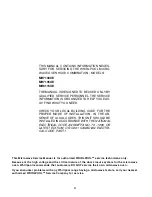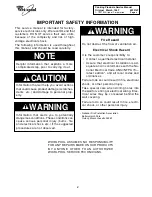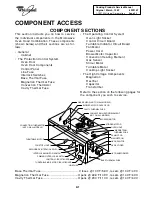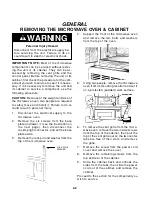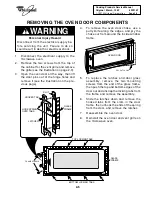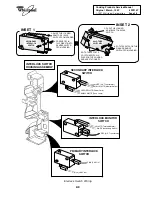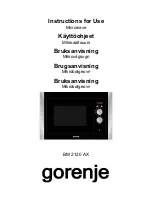
viii
R.F. LEAKAGE TEST
CAUTION
EQUIPMENT
• Electromagnetic energy leakage monitor
(NARDA 8100B, HOLADAY H1501).
• 600 ml glass beaker.
• Glass thermometer 100
°
C or 212
°
F.
TEST
On every service call, checks for microwave
energy emission must be made according to
the following manner.
1.
Remove the cooking rack from the oven
cavity, if the microwave oven is so
equipped.
2.
Place a 250 ML (8.0 oz.) glass of water in
the center of the oven bottom.
3.
Select “HIGH” cook power, turn the mi-
crowave oven on, and test for R.F. Ieakage
at the following locations using the pat-
tern shown below:
a)
Around the cabinet at the front.
b)
Around the door.
c)
Across the console panel.
d)
Horizontally across the door.
e)
Vertically across the door.
f)
Diagonally across the door.
g)
Across the air vents.
h)
Across the rear air vent.
i)
All lockseams.
j)
Weld at bottom.
k)
Bottom plate.
I)
Oven feet.
4.
The scan speed is one inch per second.
When checking for R.F. Ieakage, use an ap-
proved R.F. measuring device to assure less
than 4 mw/cm
2
emission at 5 cm distance with
a maximum scan rate of 2.5 cm/second, in
compliance with U.S. Government Department
of Health, Education and Welfare 21 CFR1030,
performance Standard for Microwave Ovens.
A properly operating door and seal assembly
will normally register small emissions, but they
must be no greater than 4 mw/cm
2
to allow for
measurement uncertainty.
NOTE: Enter leakage readings in space BE-
FORE and AFTER on the service document.
All microwave ovens exceeding the emission
level of 4 mw/cm
2
must be reported to Dept. of
Service for microwave ovens immediately and
the owner should be told not to use the micro-
wave oven until it has been repaired com-
pletely.
If a microwave oven is found to operate with
the door open, report to Dept. of Service, the
manufacturer and CDRH* immediately. Also
tell the owner not to use the oven.
* CDRH: Center for Device and Radiological Health, Food
and Drug Administration.
The interlock monitor switch acts as the final
safety switch protecting the customer from
microwave radiation. If the interlock monitor
switch operated to blow the fuse when the
interlocks failed you must replace all interlock
switches—primary and secondary interlock
switches and the monitor switch with new
ones because the contacts of those interlock
switches may be melted and welded together.
All repairs must be performed in such a man-
ner that microwave energy emissions are mini-
mal.
Address for CDRH is:
Office of Compliance (HFZ-312) Center for
Devices and Radiological Health
1390 Piccard Drive
Rockville, Maryland 20850
Summary of Contents for 1997 "E"
Page 40: ...2 30 NOTES ...


